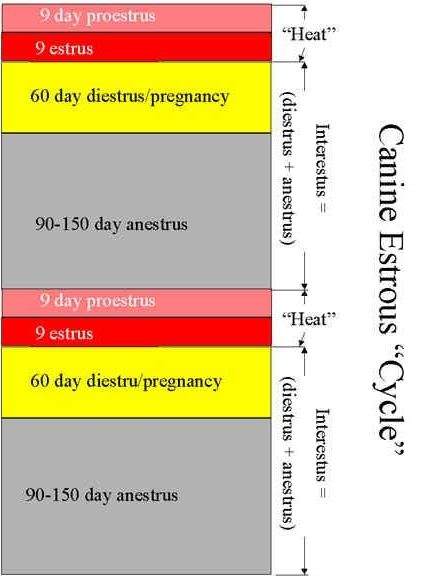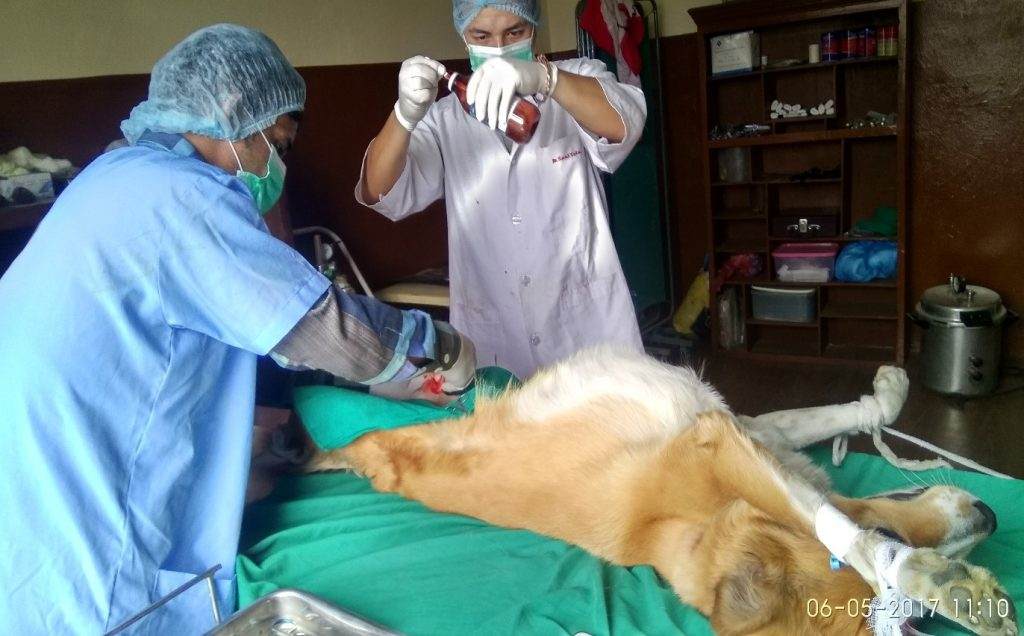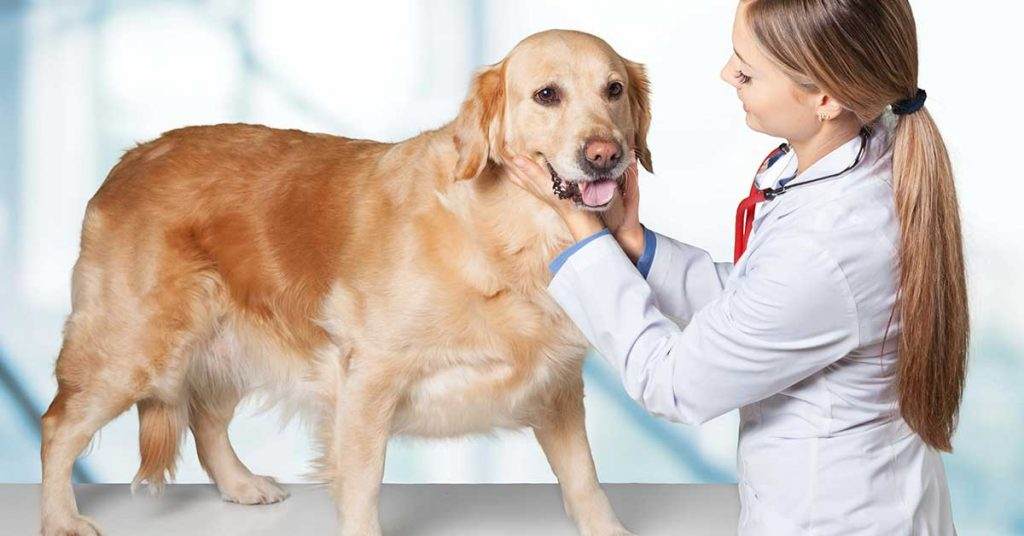
Why is birth-control required?
Owner of a female dog can adopt the plan that best suits a particular pet by considering factors like the Owner’s treatment aims, the physiological condition of the pet, and the expected side effects.
What’s Estrous/heat cycle?
- Dogs are spontaneous ovulators, di-estrous; meaning having two or more ovulation cycles per year (also commonly called “heat”).
- There’s no particular season for mating except for Basenji & Tibetan Mastiffs, which mate in the spring season.
- In dogs, every cycle is separated by an obligatory period is known as the ‘’anestrus” stage of variable duration.
- The estrus activity may vary between breeds, but it is regular for each female. The inter-estrous interval may vary between 4 and 12 months.
- For example, a 4-month inter-estrous interval is shown in some breeds of Rottweilers, German Sheepdogs, and Bernese Mountain dogs, while an average is 6–7 months in some breeds of Collies, Labradors, or Teckels.
- The reported average among all species of dogs is 6–7 months. Therefore, the contraceptive procedure needs to be planned accordingly.
- Usually in female dogs, puberty occurs when the animal reaches 70–80% of its mature body weight.

- Birth control is an effective way of controlling the population among all mammals.
- It’s followed in all mammals in a variety of ways.
- One study showed that 87 of 169 (51%) free-roaming stray animals die before 6 months of age due to dog attacks or motor vehicle accidents.
- This article focuses on the various measures for birth-control.

Surgical Method
The traditional method of population control for dogs is surgical sterilization via ovariohysterectomy and orchiectomy. However, there are many reasons why surgical sterilization may not be as effective as a non-surgical method.
Pros:
- It’s a quicker and a permanent method for contraception.
Cons:
- It requires the use of a suitable surgical facility, medical equipment, anesthesia, adequate recovery time, and the advanced training of a veterinarian which isn’t always possible for stray dogs.
- It also carries the risks of any surgical procedure.
- Many pet owners are unwilling to subject their pets to what they perceive to be a painful and invasive procedure.
- In developing countries, surgery cost is unaffordable for many owners.
- Also, many stray animals are not owned, and are under the care of animal organizations. They finance these medical procedures.
- The method of spaying & neutering these animals is labour-intensive.

Non-surgical method
Gonadotropin-releasing hormone (Gn-RH) is produced in the hypothalamus region of the brain. Gn-Rh is responsible for regulating the release of the glycoproteins luteinizing hormone (LH) and follicle-stimulating hormone (FSH) from the anterior lobe of the pituitary gland. In females, LH is responsible for ovulation, corpora lutea formation, and progesterone secretion while in males, LH stimulates testosterone production.
Pros:
- Nonsurgical methods like contraception are an effective method of population control.
- This method is an ideal nonsurgical product that is more affordable, safe, done with a single injection or treatment.
- These methods have showcased positive effects on behavior and health of pets.
Cons:
- It’s a time-consuming method.
- The effects aren’t always permanent.
Contraceptives
- A variety of possible contraceptive methods are available in the market today. However, in a significant number of countries, progestins are widely chosen, mainly due to the economic factor.
- The target population or individual along with the stated suppression period for estrus are important factors to be considered. The categories of dogs (owned dogs or stray dogs) also play a vital role in selecting the effectiveness of the contraceptive method, because they help to determine the treatment period.
- The available therapeutic options for contraception of individual female dogs are mentioned.
I. Progestins
Pros:
- Progestins are naturally occurring or synthetically produced androgens (synthetic progesterone-like compounds, also known as progestogens) is known for the longest time period as the unique contraceptive option.
- Progestins develop an artificial luteal stage.
- A progestin treatment should not be performed on a female that is already in the proestrus stage, despite being administered on the first day of heat.
Cons:
- It’s intended for a short-term suspension or postponement of estrus.
- Treatments longer than 2 years increase negative effects on the reproductive tract.
- Progestins are widely used, although these substances present a major number of side effects in dogs, which are very sensitive to prolonged use.
- A constant supply affects the gonadotropin-releasing hormone (GnRH), the follicle-stimulating hormone (FSH), and luteinizing hormone (LH) secretion
- Another major drawback for the progestins is whenever the scheduled checkup and dosing time are not followed properly.
Progestins available in the market for dogs include:
i. Medroxyprogesterone acetate (MPA)
- A vet may prescribe them as either Supprestral/Perlutex and is often supplied as both orally and by intramuscular administration.
- Close monitoring is essential for the early detection of MPA side effects.
ii. Megestrol acetate (MA)
- It’s also known as Ovarid®, Ovasteryl®, or Pilucalm®, depending on the region.
- For dogs, MA is often administered in oral form.
- A daily dose in a daily administration at the doses of 0.5 mg/kg, starting before the expected heat period by 14–30 days.
- An interval of 6 months is prescribed before administrating the next dose.
- It shows less negative side effects than MPA and therefore used for temporary estrus repression.
iii. Delmadinone (DMA) and Chlormadinon acetate
- Both DMA and CMA have a limited spread in the global market, as a result, information about is very scarce.
- DMA and CMA are usually used as anti-testosterone in male dogs for the treatment of hypersexual or prostate-related problems.
- The available DMA (Tardak® or Tardastrex®) doses for dogs are 1–2 mg/kg of body weight, injected subcutaneously.
- All treatments should start in the anestrus stage of the reproductive cycle.
- The dose for the CMA injectable formulation in dogs is 3 mg/kg body weight.
iv. Proligestone (PRG)
- This progestin possesses higher antigonadotrophic action but feebler fetus gestation period, and estrogen antagonists or estrogen blockers effect in comparison to MA and MPA.
- It’s proven to show the incidence of uterine or mammary disease, compared to the other progestins. PRG (Delvosteron®/Covinan®, Intervet).
- The recommended dosage is 10–33 mg/kg by weight.
v. Megestrol acetate (MA)
- It should not be given for successive cycles, during anestrus. The recommended dosage is 0.25 mg/lb body weight per day for 32 days.
- It can be administered orally, intact, or crushed.
II.Gn-RH agonists
Pros:
- Initially, estrus and ovulation are caused by stimulation of Gn-RH agonists which release the FSH and LH. This is a major drawback.
Cons:
- Thus, Gn-RH agonists can be used both on males and female species.
- Gonazon
- It is a controlled-release device.
- Approved by the European Union in 2006.
- In dogs, the implant is inserted subcutaneously in the umbilical area.
- Gonazon shows promising results in female dogs, and, possibly, male dogs as a safe, long-term contraceptive option.
2. Suprelorin
- It is administered in a controlled manner subcutaneously in the interscapular region.
- It was approved for use in dogs for testosterone suppression in Australia (2004) and New Zealand in (2005).
- Suprelorin is available in some European countries.
III. Gn-RH antagonists
- Gonadotropin-releasing hormone antagonists’ results in contraception by binding to the Gn-RH receptors in the pituitary and preventing Gn-RH from binding.
Pros:
- The advantages of antagonists do not cause post-treatment stimulation and estrus in female dogs and also show an immediate effect.
- Agonists are less expensive than antagonists.
Cons:
- The disadvantages are that agonists require lower doses than antagonists.
- Acyline
Acyline is a third-generation Gn-RH antagonist administered subcutaneously. It’s made up of 10 amino acids.
In male dogs, it’s responsible for:
- Decreasing scrotal diameter slightly.
- Decreasing volumes ejaculate in the second and third fractions.
- Decreasing motility sperm count and.
- Increasing sperm abnormalities.
- Decreasing libido and erection without local or systemic side effects.
In female dogs, acyline helps to terminate pregnancy about one week after it is administered, between conception and birth, and prevents normal estrus and ovulation. More research is necessary before it’s considered viable long-term contraception.
IV.Androgens
- Androgens are natural or synthetic just like progestins. They help to suppress or reduce the response of the hypothalamus-pituitary-gonadal function, which is responsible for monitoring FSH and LH. Thus, they can be used for estrus suppression.
Pros:
- It has been tested in female Greyhounds during training to avoid estrus.
Cons:
- Additional side effects described for androgen contraceptive treatments include vaginitis and uncontrolled urination.
- Also, dormancy for a prolonged period may affect their breeding after treatment is dismissed from the racetrack.
Chemical Castration
- Testicular sclerosis and permanent sterility are caused by the intratesticular injection of Esterilsol (contains zinc gluconate and amino acid arginine).
- It was the first drug approved for sterilization of companion animals by the Food and Drug Administration.
Immunocontraception
The goal of immunocontraception is to develop a vaccine to control estrus for longer. The vaccine induces antibody formation, normal reproductive function is thereby suppressed. The most common targets in immunocontraception are the zona pellucida (ZP) proteins, Gn-RH, and the LH receptor.
ZP vaccines
- Vaccines against ZP are, only effective in preventing pregnancy in females without affecting the hormonal cycle.
- It was effective at preventing pregnancy in three out of four bitches, but they required multiple immunizations intramuscularly to keep immunity high.
LH receptor vaccines
- Female dogs and cats are encapsulated in by a solid silicon rubber, sub-dermally implanted with bovine LH receptor (LH-R).
- This results in the suppression of serum progesterone concentration and depletion of estrus to form LH-R antibodies for a period of one year.
- The vaccine developed has great potential and only minor drawbacks need to be solved before making it available for practice.
Ultrasound
Ultrasound is another non-invasive technique for contraception used in male dogs.
Conclusion
- Nonsurgical methods of contraception are available options to control overpopulation among dogs. Some of the approved products like Ultrasound, Gonazon, Suprelorin, Neutersol, Esterilsol, and Infertile are limited to certain countries.
- Extensive research and development are currently underway on Gn-RH agonists and antagonists, VCD, immunocontraception, LH receptors, and chemical castration. The products mentioned above don’t meet all the criteria set forth by the Alliance for Contraception in Cats and Dogs.
- Therefore, temporary contraception is most widely used for privately owned dogs, while for community-owned or ownerless dogs, sterilization (surgical or chemical) remains a better option.
References
- https://www.jurox.com/sites/default/files/resources/AU%20-%20Tech%20Note%20-%20Tardak%20-%20DIGITAL.pdf
- http://therio.vetmed.lsu.edu/the_normal_canine.htm
- https://www.acc-d.org/
Table of Contents




